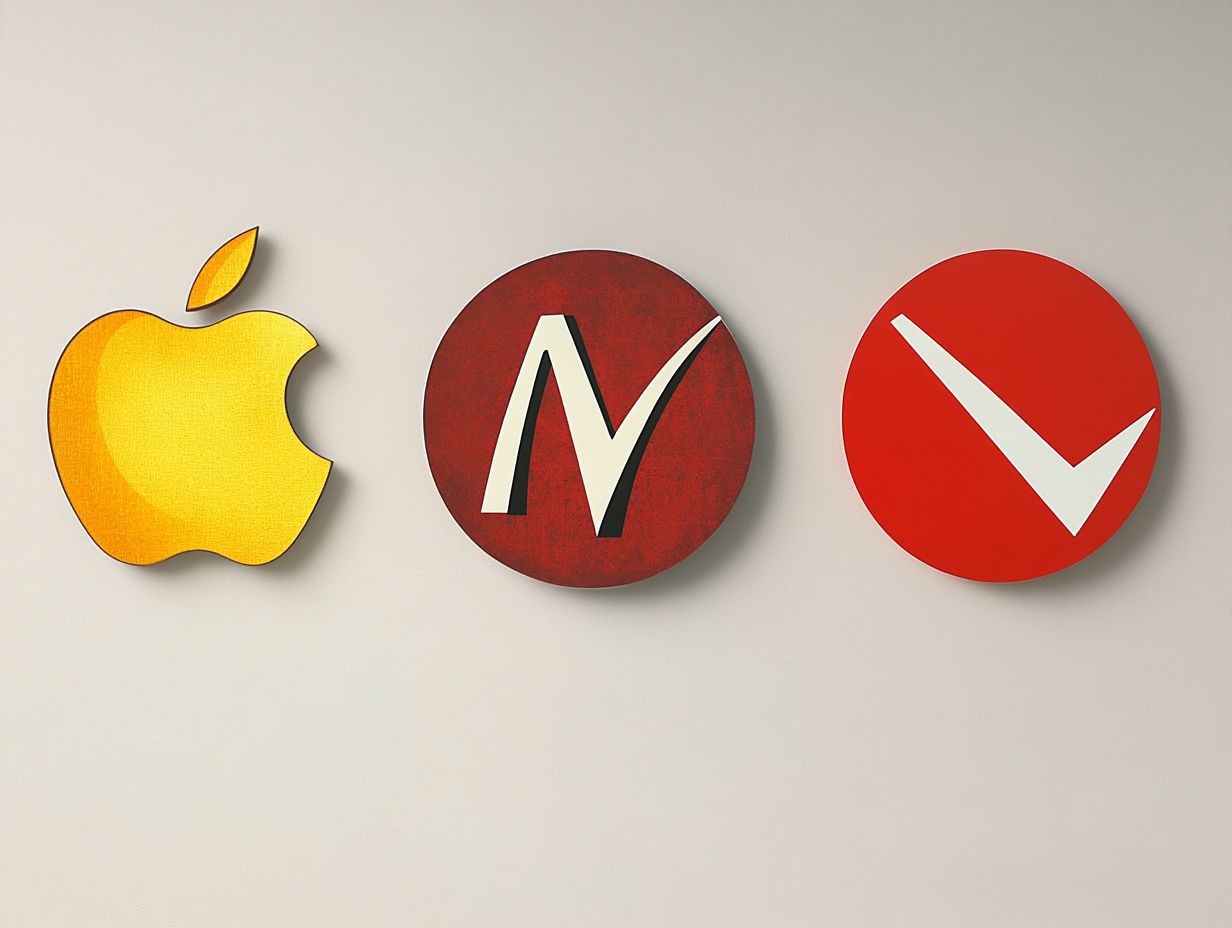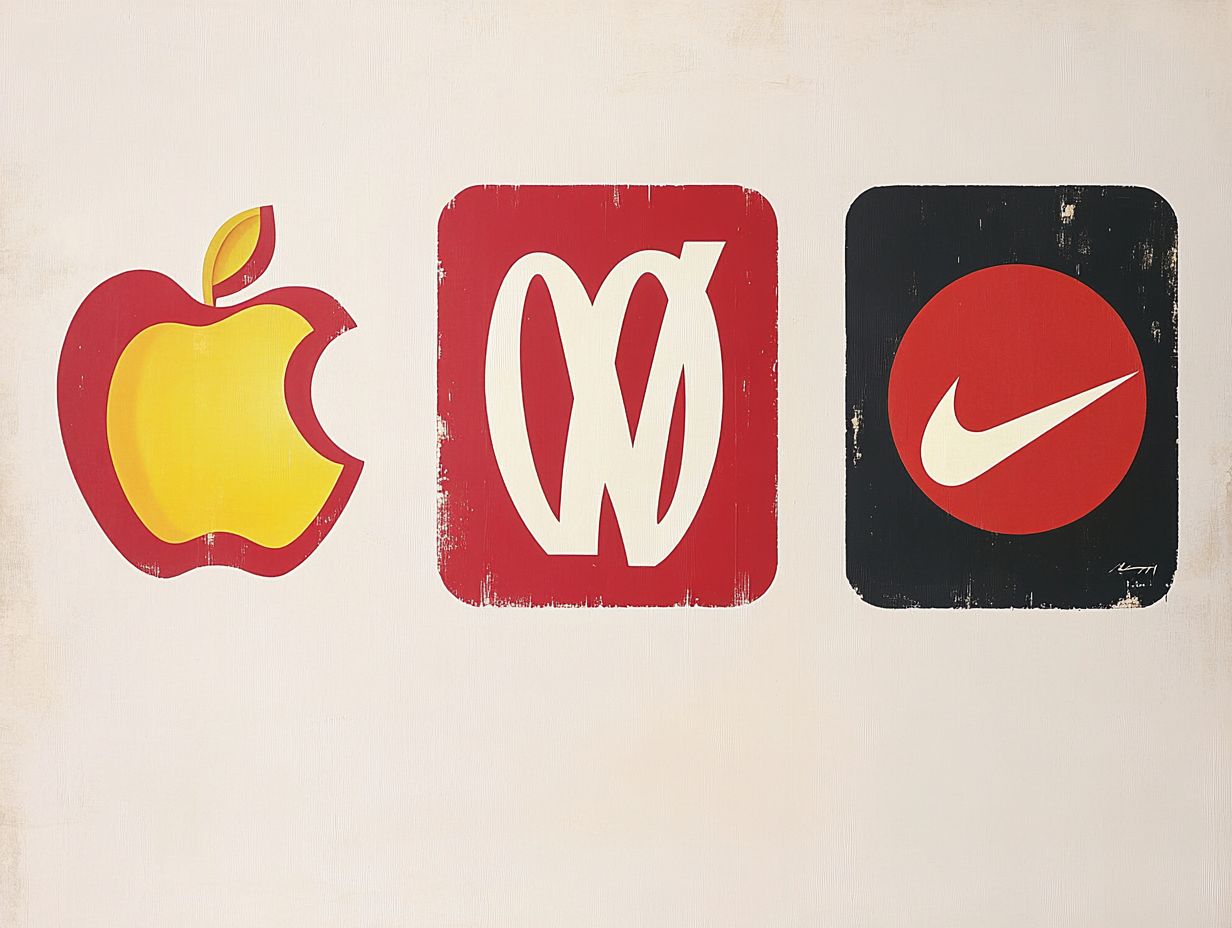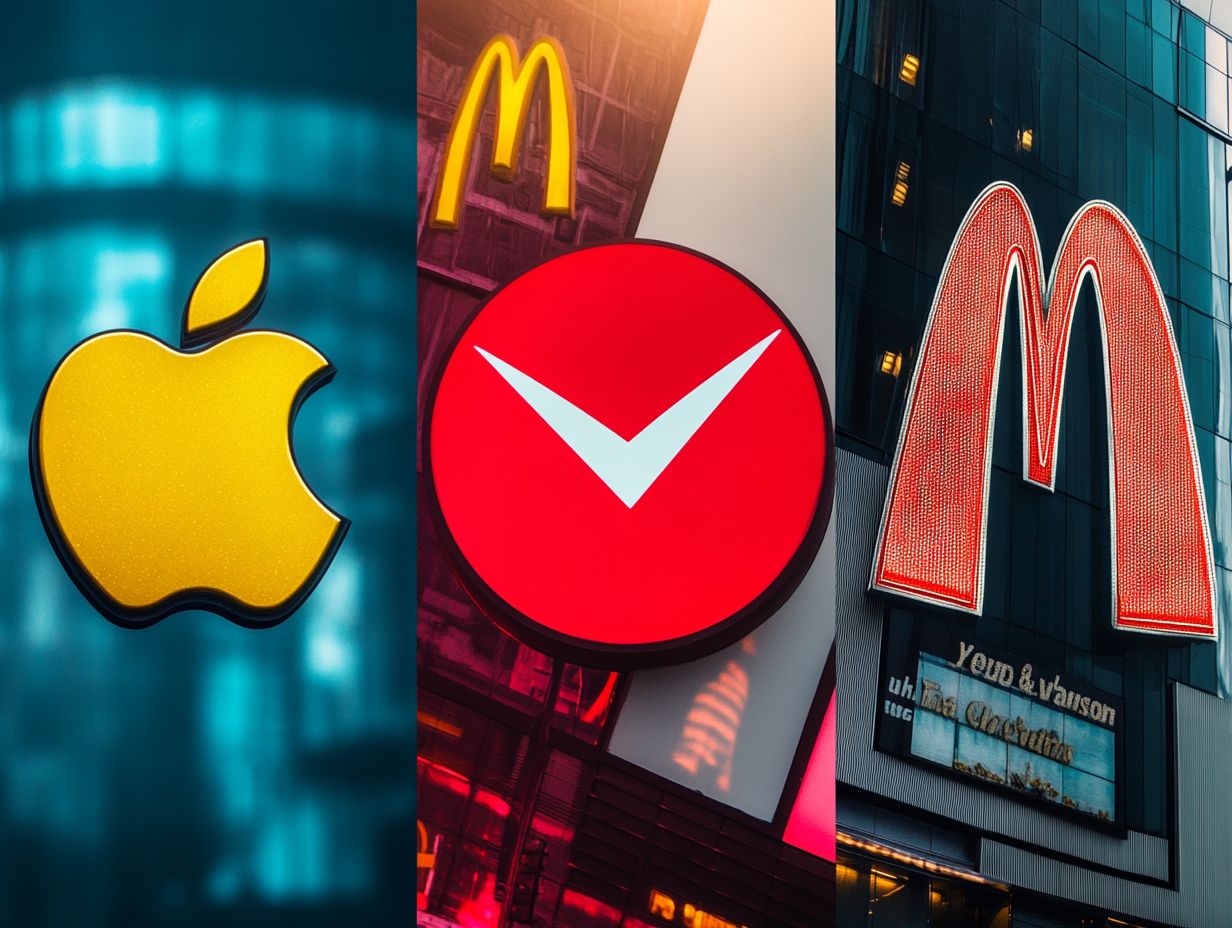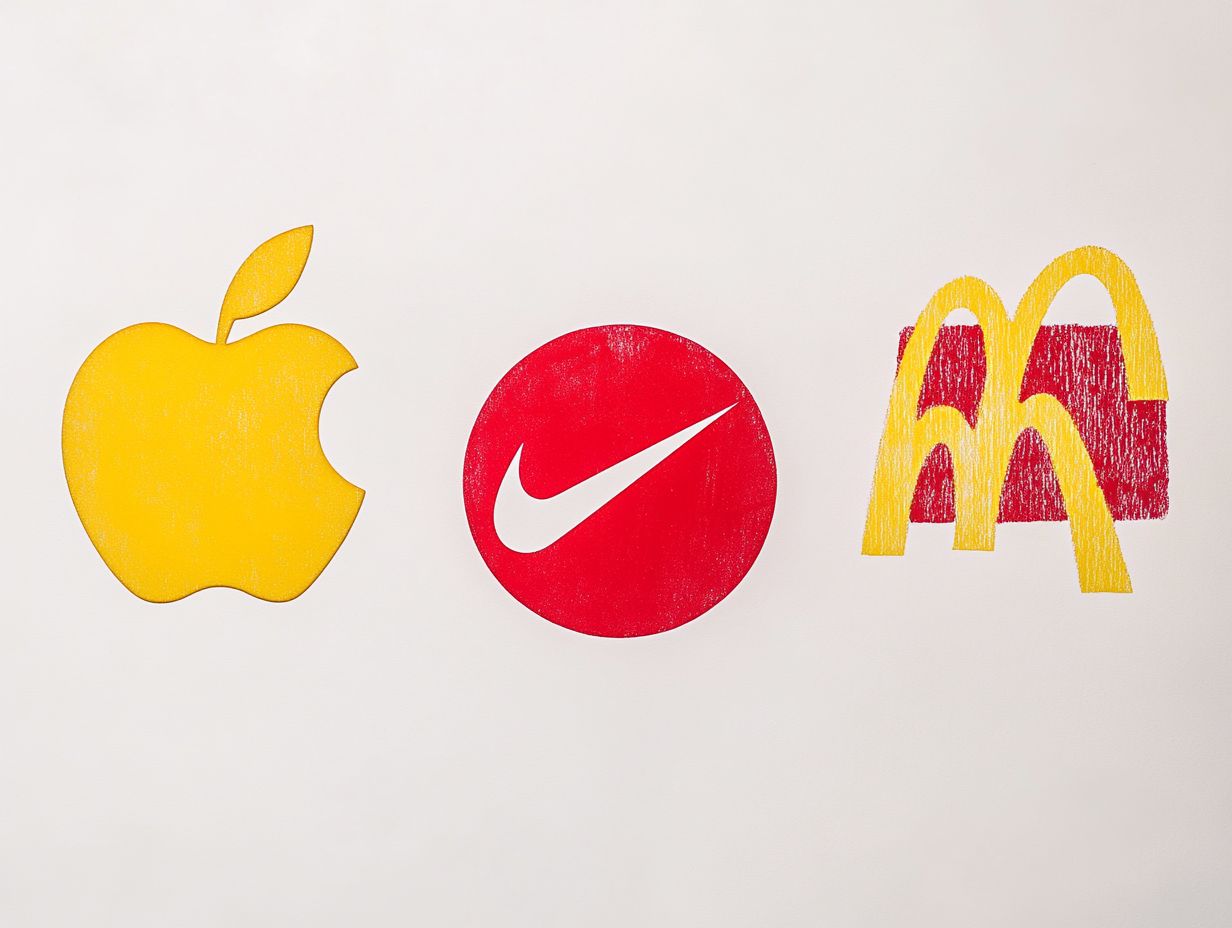5 Notable Trademarks and Their Histories
Trademarks, symbols or words that represent a company, play a significant role in branding. They are more than just designs; they capture the essence of a brand, reflecting its identity and values in an elegantly simple form.
This article invites you to delve into the stories of five iconic trademarks: the Nike Swoosh, Coca-Cola Logo, McDonald’s Golden Arches, Apple Logo, and Google Logo. You’ll uncover the intriguing narratives behind these symbols, their evolution over time, and the crucial roles they play in driving their companies’ success.
You will also explore why trademarks are important, their many benefits, and valuable lessons other businesses can learn from these powerhouse brands. Get ready to see how these logos truly shape our world!
Contents
- Key Takeaways:
- The Nike Swoosh
- The Coca-Cola Logo
- The McDonald’s Golden Arches
- The Apple Logo
- The Google Logo
- How Important Is a Trademark for a Company?
- What Are the Benefits of Having a Strong Trademark?
- What Are the Key Elements of a Successful Trademark?
- How Can a Company Protect Their Trademark?
- What Are the Consequences of Infringing on a Trademark?
- How Have These Trademarks Evolved over Time?
- What Are the Stories Behind These Famous Trademarks?
- How Have These Trademarks Impacted the Success of Their Respective Companies?
- What Are Some Lesser-Known Facts About These Trademarks?
- How Have These Trademarks Influenced Popular Culture?
- What Are Some Controversies Surrounding These Trademarks?
- What Can Other Companies Learn from the Success of These Trademarks?
- What Does the Future Hold for These Trademarks and Their Companies?
- How Can a Company Create a Memorable and Effective Trademark?
- Frequently Asked Questions
Key Takeaways:

The Nike Swoosh, Coca-Cola Logo, McDonald’s Golden Arches, Apple Logo, and Google Logo are all iconic trademarks that have evolved over time and have had a significant impact on their respective companies.
A strong trademark boosts brand recognition and offers legal protection. It should be memorable, distinct, and representative of the company’s values.
Companies must take proactive measures to protect their trademarks, as infringing on a trademark can have serious consequences. These famous trademarks have also influenced popular culture and have been involved in controversies.
The Nike Swoosh
The iconic Nike Swoosh is more than just a logo; it embodies a powerful brand synonymous with athletic achievement and innovation.
Its connection with legendary athletes like Usain Bolt enhances its significance. Bolt’s remarkable Olympic golds and signature victory pose reinforce the brand’s stature in sports culture.
Originally crafted in 1971 by graphic design student Carolyn Davidson, the Swoosh was inspired by the wings of the Greek goddess Nike, symbolizing speed and movement. Over the years, it has transformed from a simple design into a potent symbol recognized globally, transcending its identity as merely a trademark.
The Swoosh has been instrumental in Nike’s rise to one of the largest sportswear brands, embraced by athletes and consumers alike for its powerful identity.
With athletes like Bolt epitomizing excellence and endurance while adorned with the Swoosh, this logo continues to resonate deeply with fans and aspiring athletes worldwide, solidifying its position in both sports history and popular culture.
The Coca-Cola Logo
The Coca-Cola logo, with its signature script and vivid red hue, stands as a prime example of a trademarked image that has garnered unparalleled brand recognition across the globe. It represents not merely a beverage but an entire culture steeped in happiness and refreshment.
Originally crafted in 1886 by Frank M. Robinson, the logo’s elegant Spencerian script was designed to evoke a sense of quality and tradition, perfectly capturing the pioneering spirit of the company.
Over the years, it has seen subtle tweaks while retaining its original cursive charm, ensuring it resonates with both new and loyal consumers.
This enduring visual identity has been important in advertising strategies, enriching popular culture, and making appearances in art, film, and fashion. It has become an emblem of joy and togetherness, embraced worldwide. Its ability to evoke nostalgia and familiarity continues to bolster its status as a timeless icon.
The McDonald’s Golden Arches
The McDonald’s Golden Arches are not just a symbol of fast food; they represent a global franchise that has achieved remarkable brand recognition, becoming a cultural icon synonymous with convenience and culinary nostalgia. This is something cherished by both children and adults across generations.
These iconic arches, first introduced in the 1960s, have evolved beyond their original purpose to signify not merely a meal, but a unique experience that resonates on a personal level.
Through innovative marketing strategies and memorable advertisements, they ve crafted an image of reliability and familiarity, enticing consumers who seek comfort in their busy lives.
This branding has solidified the fast-food chain’s presence in various markets and prompted competitors to rethink their own visual identities. As a result, the Golden Arches have emerged as a powerful symbol in the broader conversation surrounding brand loyalty and consumer behavior.
The Apple Logo
The Apple logo, with its elegantly simple design of an apple featuring a bite taken out, represents innovation and sophistication in technology. It has achieved remarkable brand recognition, earning its place among the most powerful trademarks in history.
This iconic emblem, crafted in the 1970s by Rob Janoff, embodies the company’s creative spirit and reflects the evolving values of creativity and individuality that consumers may aspire to.
Its sleek design effortlessly conveys a sense of simplicity and sophistication, inviting you to integrate technology into your lifestyle seamlessly.
Over the decades, the logo transformed while maintaining its core identity. This evolution solidified its role in Apple s branding and marketing strategies, ensuring it remains a timeless symbol of excellence.
The Google Logo
The Google logo, with its vibrant colors and sleek typography, exemplifies the company s dedication to simplicity and innovation. Its design has achieved remarkable brand recognition globally, perfectly reflecting Google’s mission to organize the world s information.
As you ve seen, this iconic design evolved alongside technological advancements and cultural shifts embraced by the company. Each iteration, whether through font tweaks or dynamic color palettes, was crafted to make the brand feel accessible and relatable.
This evolution builds your trust, as the logo remains a familiar anchor in the ever-changing digital landscape. It reinforces its significance in branding strategy and user engagement.
How Important Is a Trademark for a Company?

A trademark is an invaluable asset for any business, offering legal protections for your brand identity, enhancing brand recognition, and allowing you to stand out in a crowded marketplace. The rich history of trademarks highlights their necessity in today s commercial landscape.
In a world brimming with choices, securing trademarks is critical. By obtaining trademarks for unique identifiers like logos and slogans you protect your brand and foster trust and loyalty among consumers.
The journey to obtaining a trademark involves several key steps, including:
- Conducting thorough searches to ensure originality.
- Filing the application.
- Navigating potential oppositions.
Successfully completing this process strengthens your market position and acts as a deterrent against infringement, ensuring your business’s long-term sustainability and growth.
What Are the Benefits of Having a Strong Trademark?
A strong trademark offers a wealth of advantages, from enhanced brand recognition to increased consumer trust, establishing a unique market presence that can significantly elevate your company’s value.
Robust trademarks act as a legal shield, safeguarding your business from potential infringement and enabling you to take legal action against unauthorized use.
This protection secures your brand s reputation and fosters trust among consumers, leading to increased loyalty.
Brands like Nike and Apple harness their trademarks to forge lasting connections with customers, giving them a competitive edge in the market.
By cultivating a distinctive brand identity, you can differentiate yourself from competitors and command premium pricing, ultimately elevating your overall profitability.
In today s fast-paced world, securing your trademark is not just important it s essential for your brand s survival! Don t wait! Start your trademark journey today to safeguard your brand’s future!
What Are the Key Elements of a Successful Trademark?
Successful trademarks embody key elements like distinctiveness, simplicity, and relevance to the product or service. These factors significantly enhance brand recognition and establish a strong market presence, a truth well illustrated by the historical evolution of trademarks across various industries.
Consider iconic brands such as Apple and Nike. They ve crafted trademarks that are not only memorable but also evoke a sense of quality and innovation, making them instantly recognizable.
As you navigate the trademark application process, assessing these qualities becomes crucial. An effective evaluation requires you to consider the uniqueness of your mark in relation to similar products, ensuring it doesn t merely describe the goods you offer. You should also examine its emotional and cultural resonance with your target audience.
By concentrating on these essential components, you can secure a trademark that truly stands out in a crowded marketplace, ultimately setting the stage for enduring success.
How Can a Company Protect Their Trademark?
You can protect your trademarks through a careful application process, vigilant monitoring for infringement, and active protection of your rights. This helps keep your brand identity strong.
Carefully filing for trademark registration gives you a legal claim to your brand, enabling you to prevent others from misusing similar identifiers. Continuous vigilance in monitoring the marketplace for potential infringements is crucial. Leveraging automated tools and legal teams can significantly enhance your efforts in this area.
If a conflict arises, be prepared to take assertive legal action to defend your intellectual property. A notable case involved Starbucks, which famously pursued legal action against a small coffee shop for using a similar name. This shows how serious companies take protecting their brands.
What Are the Consequences of Infringing on a Trademark?
Infringing on a trademark can have serious consequences for your business, including legal penalties, loss of brand recognition, and damage to your company s reputation. This underscores the importance of understanding trademark history and respecting intellectual property rights.
For your business, the ramifications of such infringements can be profound. You could face costly lawsuits that drain your resources and require you to hire expensive legal advisors.
Financial penalties can vary, from monetary damages awarded to the aggrieved party to legal fees that could significantly impact your bottom line.
High-profile cases, like the litigation between Apple and Samsung over smartphone designs, illustrate not only the potential for substantial settlements but also how these disputes can shape market perceptions. Such incidents highlight the critical importance of safeguarding your brand’s integrity through diligent trademark practices.
How Have These Trademarks Evolved over Time?
The evolution of trademarks over time showcases a fascinating interplay between design trends, cultural shifts, and changes in consumer preferences. It highlights how effective brand recognition is achieved through a commitment to adaptation and innovation in trademark history.
Take the iconic Coca-Cola logo, for example. The Coca-Cola logo has evolved since the late 19th century, reflecting the changing tastes of consumers. These updates not only mirror the changing aesthetics of different eras but also connect with the evolving sentiments of consumers.
Similarly, Apple Inc. has consistently led the charge in the technology industry by reinventing its logo and brand image to keep pace with advancements in design and technology. These examples show how successful brands understand the necessity of evolving their trademarks to stay relevant and appealing in an increasingly competitive landscape.
What Are the Stories Behind These Famous Trademarks?

Every famous trademark has a unique story. These narratives reflect the brand’s values and challenges, helping you understand how effective storytelling and marketing create brand recognition.
Take, for example, the iconic swoosh of a renowned sports apparel company. Inspired by the wing of the Greek goddess of victory, it symbolizes motion and speed. This design choice was not just about aesthetics; it was a clever branding strategy that deeply resonated with athletes and fitness enthusiasts.
By weaving narrative and visual identity, this trademark became more than just a label; it transformed into a lifestyle, capturing the hearts of audiences worldwide. Such compelling stories enrich brand identity, foster loyalty, and create emotional connections, proving that a powerful narrative can elevate a trademark to a cultural icon.
How Have These Trademarks Impacted the Success of Their Respective Companies?
The impact of trademarks on your company’s success is immense. Strong brand recognition can elevate a simple product into a household name, driving sales and loyalty.
Today’s competitive marketplace highlights this idea. As you explore the journeys of various organizations, it becomes clear that their distinctive symbols have played a crucial role in shaping consumer perceptions and building trust.
Consider this: a well-crafted trademark sets your business apart and enhances your ability to command premium pricing, ultimately boosting your financial performance. Discover how companies have boldly used their trademarks to dominate the market and build lasting relationships with their customers.
What Are Some Lesser-Known Facts About These Trademarks?
Many well-known trademarks come with intriguing backstories that reveal their origins, design choices, and complex legal journeys, enriching your appreciation for the brands you encounter daily. Discover 5 things you didn’t know about trademarks to learn more about their fascinating history.
Take, for instance, the iconic swoosh of a certain sports brand. This emblem was born from the creative vision of a college student with a desire to capture movement. That simple design embodies athleticism and tells the tale of its creator’s early trademark disputes.
These narratives illuminate how trademarks carry personal significance and legal intrigue. They transform into compelling stories that resonate deeply with you, connecting you to the values and history behind your favorite brands.
How Have These Trademarks Influenced Popular Culture?
Trademarks have significantly shaped popular culture, serving as powerful symbols of lifestyle, values, and identity that resonate with you and influence societal trends.
Consider the iconic swoosh of a certain athletic brand it’s instantly recognizable and appears everywhere, from high-fashion runways to blockbuster movies. This logo represents quality and performance and contributes to a larger cultural narrative that links athleticism with success.
Similarly, a particular luxury handbag has evolved from a simple accessory into a status symbol, often showcased by celebrities on social media, reinforcing its allure among consumers like you.
These trademarks shape your personal style and influence your choices, illustrating how deeply woven these symbols are into the fabric of contemporary culture.
What Are Some Controversies Surrounding These Trademarks?
Controversies surrounding trademarks often highlight the complex relationship between branding, identity, and intellectual property rights. They prompt important questions about ownership, using cultural symbols without permission, and the ethical aspects of brand representation.
Disputes can arise as high-profile legal battles over logos or as debates about cultural representation in marketing.
For instance, when a brand uses cultural symbols without proper acknowledgment, it risks accusations of exploitation, leading to public outrage and consumer backlash.
Such situations not only harm the companies involved but also shape perceptions of authenticity and social responsibility. Brands must navigate the balance between creative expression and ethical considerations, especially as consumers become more aware of these issues.
What Can Other Companies Learn from the Success of These Trademarks?
The success of well-known trademarks offers valuable lessons for emerging companies. These lessons emphasize the importance of strategic branding, consistent messaging, and understanding trademark history to achieve brand recognition.
By examining the paths of industry giants, you can learn how to differentiate your products through innovative branding techniques. Creativity in logo design and customer engagement can set you apart in a crowded marketplace.
Staying attuned to market trends and consumer needs helps your brand evolve dynamically, ensuring your messaging remains relevant and appealing.
Focus on crafting a unique brand story that resonates with your audience. This approach fosters loyalty and creates a sense of community around your products, making your brand more appealing.
What Does the Future Hold for These Trademarks and Their Companies?

The future of trademarks depends on brands’ ability to adapt to changing consumer preferences and technological advancements. To thrive, brands must innovate continuously while maintaining brand recognition and honoring trademark history.
As society emphasizes sustainability, brands need to incorporate eco-friendly practices into their identities. This shift influences not only trademark design and messaging but also the materials and processes used in production.
In the digital age, this evolution accelerates as brands leverage social media and online platforms to engage with consumers in real time. Trends show that well-known trademarks will increasingly adopt transparent and socially responsible practices, creating a marketplace where authenticity and environmental stewardship are paramount.
In essence, the next phase of trademark evolution requires brands to balance legacy with modern values, forging meaningful connections with a conscious audience.
How Can a Company Create a Memorable and Effective Trademark?
Creating a memorable and effective trademark requires a deep understanding of your company s values, market positioning, and consumer expectations. These elements combine to form a brand identity that resonates with your target audience and enhances brand recognition.
Start by holding brainstorming sessions to encourage creativity and gather diverse ideas from stakeholders. This collaboration will generate concepts that align with your brand’s mission.
Next, consider elements like color psychology, typography, and visual aesthetics in the design phase. These factors should embody your brand’s essence.
Once you have a few concepts, test them by gathering feedback from potential customers. This feedback provides crucial insights into what resonates and what doesn’t.
Throughout this process, ensure your trademark remains unique and relevant. This differentiation will help your trademark stand out in a crowded marketplace.
Frequently Asked Questions
What are some notable trademarks and their histories?
Some notable trademarks include:
- Coca-Cola: Known for its iconic logo and classic beverage, it has a rich history that dates back to 1886.
- McDonald’s: Famous for its golden arches, McDonald’s revolutionized fast food and has a global presence.
- Nike: Recognizable by its swoosh logo, Nike has become synonymous with athletic wear and innovation.
- Apple: Known for its sleek design and user-friendly technology, Apple has a loyal customer base and a significant impact on consumer electronics.
- Disney: A leader in entertainment, Disney’s storytelling and brand magic have captivated audiences for decades.
When was the trademark for Coca-Cola established?
Coca-Cola’s trademark began in 1886. It was created by pharmacist John Pemberton in Atlanta, Georgia.
What is the history behind the trademark for McDonald’s?
McDonald’s trademark started in 1953. Brothers Richard and Maurice McDonald opened their first restaurant in San Bernardino, California.
How did Nike’s trademark come about?
In 1971, Nike’s iconic trademark burst onto the scene. Co-founder Phil Knight was inspired by the Greek goddess of victory, Nike.
When was the trademark for Apple created?
Apple’s trademark was created in 1977. This marked the launch of their first personal computer, the Apple II.
What is the significance of Disney’s trademark?
Disney’s trademark, the Mickey Mouse logo, was created in 1928. It has become one of the most recognizable symbols globally, reflecting the company’s influence on entertainment.






